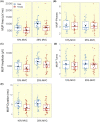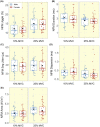Neuromuscular recruitment strategies of the vastus lateralis according to sex
- PMID: 35184382
- PMCID: PMC9286427
- DOI: 10.1111/apha.13803
Neuromuscular recruitment strategies of the vastus lateralis according to sex
Abstract
Aim: Despite males typically exhibiting greater muscle strength and fatigability than females, it remains unclear if there are sex-based differences in neuromuscular recruitment strategies e.g. recruitment and modulation of motor unit firing rate (MU FR) at normalized forces and during progressive increases in force.
Methods: The study includes 29 healthy male and 31 healthy female participants (18-35 years). Intramuscular electromyography (iEMG) was used to record individual motor unit potentials (MUPs) and near-fibre MUPs from the vastus lateralis (VL) during 10% and 25% maximum isometric voluntary contractions (MVC), and spike-triggered averaging was used to obtain motor unit number estimates (MUNE) of the VL.
Results: Males exhibited greater muscle strength (P < .001) and size (P < .001) than females, with no difference in force steadiness at 10% or 25% MVC. Females had 8.4% and 6.5% higher FR at 10% and 25% MVC, respectively (both P < .03), while the MUP area was 33% smaller in females at 10% MVC (P < .02) and 26% smaller at 25% MVC (P = .062). However, both sexes showed similar increases in MU size and FR when moving from low- to mid-level contractions. There were no sex differences in any near-fibre MUP parameters or in MUNE.
Conclusion: In the vastus lateralis, females produce muscle force via different neuromuscular recruitment strategies to males which is characterized by smaller MUs discharging at higher rates. However, similar strategies are employed to increase force production from low- to mid-level contractions. These findings of similar proportional increases between sexes support the use of mixed sex cohorts in studies of this nature.
Keywords: motor unit; neuromuscular junction; sex differences; vastus lateralis.
© 2022 The Authors. Acta Physiologica published by John Wiley & Sons Ltd on behalf of Scandinavian Physiological Society.
Conflict of interest statement
The authors have no conflict of interest to declare.
Figures






References
-
- Heckman CJ, Enoka RM. Motor unit. Compr Physiol. 2012;2(4):2629‐2682. - PubMed
-
- Allen MD, Stashuk DW, Kimpinski K, Doherty TJ, Hourigan ML, Rice CL. Increased neuromuscular transmission instability and motor unit remodelling with diabetic neuropathy as assessed using novel near fibre motor unit potential parameters. Clin Neurophysiol. 2015;126(4):794‐802. - PubMed
Publication types
MeSH terms
Substances
Grants and funding
LinkOut - more resources
Full Text Sources
Research Materials

